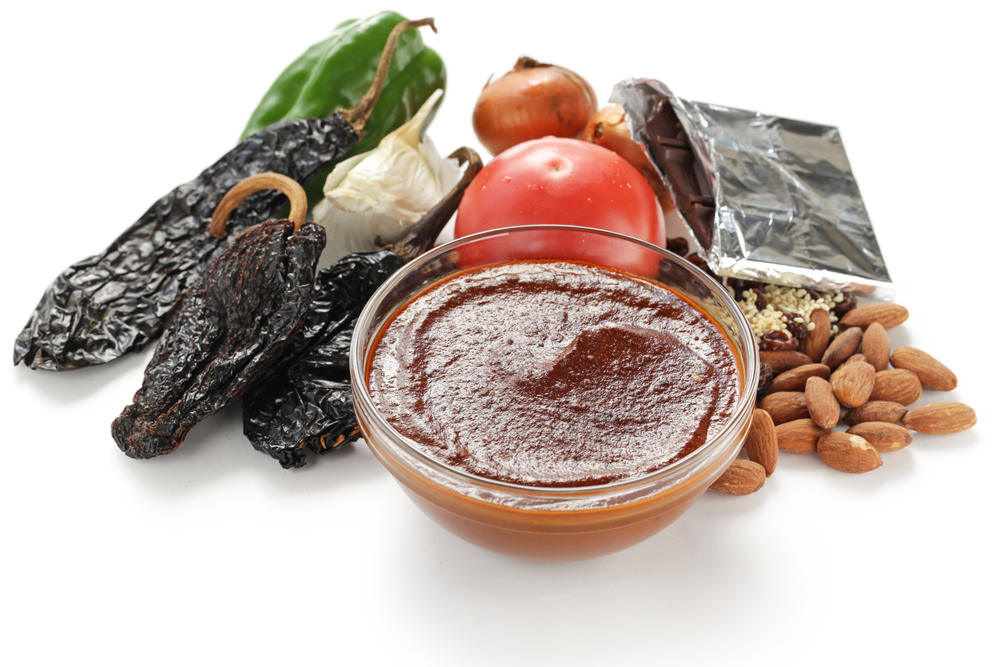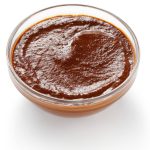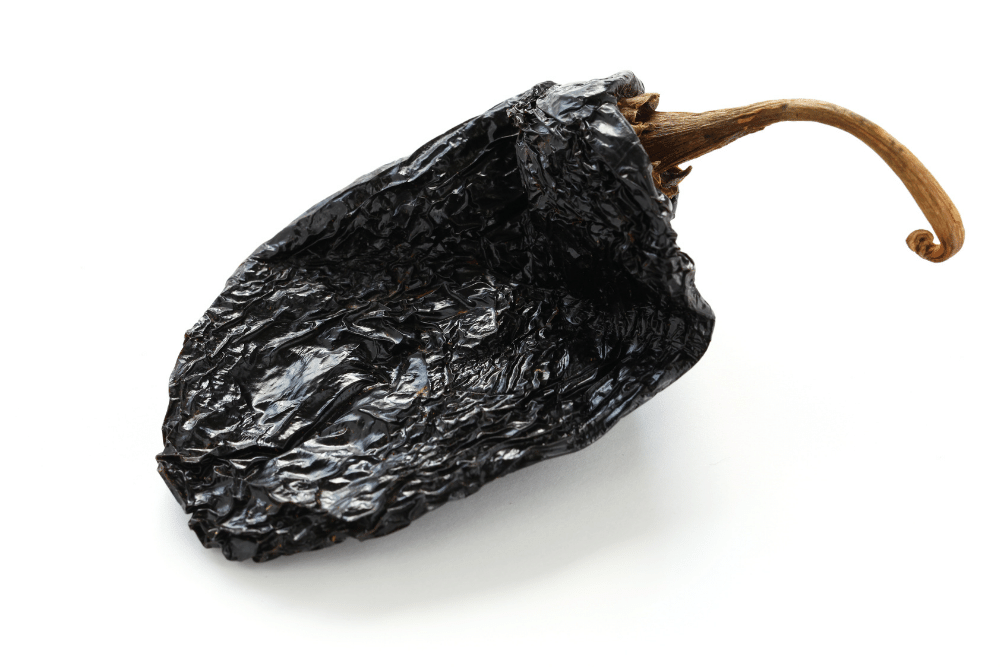Mulato peppers start as poblano chili peppers, allowed to grow longer and overripen on the pepper plant before being harvested and dried. They are sweeter, fruitier, and hotter than ancho chiles—their dried poblano pepper relatives.
What Is A Mulato Pepper?
Mulato peppers are dried poblano peppers left to age and overripen on the vine to a dark brown color. They botanically belong to the Capsicum annuum species.
Together with ancho chilis and pasilla peppers, mulato peppers form the “Holy Trinity”— a blend of peppers commonly used in Mexican food.
You can identify mulato peppers based on color, size, shape, flavor, and texture.

Color
Like other peppers, mulato peppers start green, ripening to bright red, with the possibility of darker hues when left to age and overripen on the pepper plant.
Once dried, mulato peppers have dark brown skin, usually described as a brownish-dark color that’s almost black.
Texture
The wrinkled semi-thick skin of mulato peppers is a system of creases and folds. The skin is dry and pliable, even though it’s almost brittle. The dried chili pods are attached to a golden fibrous stem.
Shape And Size
Mulato peppers have a triangular shape. They are wide at the top and taper to a blunt end.
The peppers are about 4 inches (10 centimeters) long on average and about 2 inches (5 centimeters) wide.
Flavor
Most dried peppers have a complex flavor profile, and mulato peppers are no exception. Mulatos have a sweet, fruity, earthy licorice or chocolatey flavor with delicate hints of cherries, smoke, tobacco, and coffee.
The smoky flavor gets more pronounced when you roast or toast the peppers before rehydrating them to make a puree.
Mulato peppers are sweeter and fruitier than ancho chiles because they are let to grow longer on the plant to an overripe stage.
Are Mulato Chiles And Ancho Chiles The Same?
Mulato peppers and ancho chiles are dried poblanos in different stages of ripeness.
While ancho peppers are dried poblanos harvested when red (or green just before ripening and allowed to ripen to red off the plant), mulato peppers are dried poblano peppers harvested when overripened on the vine to a dark brown color.
How Spicy Is A Mulato Pepper?
Mulato peppers have mild to moderate spiciness at 2,500-3,000 Scoville Heat Units. They are spicier than ancho chiles, which hit between 1,000-2,000 SHUs on the Scoville Scale.
The increased hotness of mulato peppers compared to anchos is due to the higher levels of capsaicin. Peppers left to age and ripen longer on the vine have higher levels of capsaicin and are thus hotter.
Dried Anaheim or New Mexico peppers have a Scoville score of 500-2,500 SHUs, meaning they are milder, but some varieties may equal the spiciness of the least hot Mulato pepper.
The least hot Mulato pepper has the same spiciness as the hottest chile pasilla, which has 1,000-2,500 SHUs.
What Are Mulato Peppers Used For?
Mulato peppers are versatile peppers because of their complex flavor profile. They are a popular spice in Mexican cuisine if mild to moderate heat is required from a dried pepper.
The famous mole poblano sauce features mulato peppers that add sweetness, fruitiness, and a chocolatey, smoky flavor.

Reconstituted mulato peppers are chopped or pureed into Mexican sauces, stews, and soups. Rehydrating or reconstituting the peppers usually involves soaking them in hot water for 10-30 minutes.
Before reconstituting the peppers, try roasting them to enhance the smoky flavor. You can discard the steeping water or use it to lighten sauces if it isn’t bitter.
You can use mulato peppers in marinades and sauces like enchilada sauce and adobo sauce. They are also ground into mulato chili powder, commonly used whenever a mild, smoky chili powder is needed. Chili powder can be mixed with salt, herbs, and spices as a dry rub for meats.
Mulato peppers are crushed roughly into pepper flakes and served with chocolate cakes, fresh fruits, or desserts like ice cream for a sweet and spicy treat.
Are There Other Names For Mulato Chiles?
Mulato peppers are also called mulato chiles/chilis or chile mulato.
How Are Mulato Peppers Different From Cayenne Peppers?
Dried cayenne chili powder is a lot hotter than mulato chili powder.
Cayenne peppers clock 30,000-50,000 SHUs as moderately hot peppers. In contrast, mulato chile peppers are considered mild at 2,500-3,000 Scoville Heat Units.
What’s The Difference Between A Mulato Pepper And A Dried Jalapeno?
Dried red jalapeno peppers are called chipotle peppers. They take two forms—chipotle morita, smoked for a shorter time, and chipotle meco, harvested when fully ripened and smoked twice longer than chipotle morita peppers.
Both versions of chipotle peppers are ground into chipotle chili powder and used to flavor marinades, sauces, and different raw and cooked dishes.
A notable difference in usage between mulato peppers and chipotle peppers is seen in how they flavor adobo sauce. Chipotle peppers are used whole in adobo sauce, while mulato peppers are used in adobo sauce when reconstituted and pureed. The other significant difference is the heat, as jalapenos are spicier at 2,500-8,000 SHUs.
Where To Buy Mulato Peppers
Mulato peppers are less common in supermarkets or physical stores than ancho peppers, but you can find them online from outlets like Amazon.
“Fresh mulato peppers” are hard to come by since the poblanos are left to overripen on the plant. The dark brown peppers are dried shortly after harvesting. The name mulato refers to only the dried version of the pepper. This means that even in its overripe stage, a mulato pepper is still a poblano until it’s dried.
If you live in an area with specialty stores or supermarkets with a Hispanic section or Mexican food aisle, you might easily find whole dried mulato peppers.
Substitutes For Mulato Peppers
You can substitute mulato peppers with other dried peppers like pasilla chiles (dried chilaca chiles), chipotle (chipotle meco or chipotle morita—both dried red jalapenos), and ancho chiles.
Dried Anaheim peppers are also an excellent substitute for mulatos when you want milder heat (500-2,500 SHUs).
Dried guajillo chiles (2,500-5,000 SHUs) will make your dish spicier or have the same spiciness as a dish cooked with 2,500-SHU chile mulato peppers.
Can You Grow Mulato Peppers?
Poblano peppers are easy to grow in the average home garden. The peppers do well in well-drained, sandy-loam soils in warm climates. They prefer warm and dry sunny days and cool, dry nights.
Mulato chiles are growable in gardens and containers from heirloom poblano seeds bought online. The seeds are rarely available in garden centers.
You’ll need to start the pepper seeds indoors about 8-10 weeks before the last frost date and transplant them about 2-3 weeks after the last spring frost.
The average poblano pepper plant will bear 8-10 fruits. You can harvest the pods when overripened to a dark brown and dry them in the oven or dehydrator to make mulato peppers.
How To Make Mulato Pepper Sauce
You can make four cups of homemade mulato pepper sauce using the following ingredients and instructions. You can refrigerate your mulato pepper sauce for up to four weeks in an airtight glass container.
Print
Mulato Pepper Sauce
- Total Time: 45 minutes
Description
A rich and delicious tomato and mulato chile sauce that goes with any Mexican fare.
Ingredients
- 10 mulato peppers
- 2 tbsp peanut oil or extra virgin olive oil
- 12 peeled, medium-sized cloves of garlic
- 2 tbsp sesame seeds
- 1 tsp dried oregano
- 1 1/2 diced onions
- 12 peeled tomatoes
- 1 cup tomato juice
- 1 1/2 tsp cumin seeds or 2 teaspoons of ground cumin
- 2 1/2 cups thinning liquid (tap water or pepper steeping water)
Instructions
- Heat a 12-inch cast iron skillet over medium heat until it gets evenly hot. Place the mulato peppers in the skillet and toast them for about 2 minutes on each side.
- Cool the toasted peppers and remove the seeds and core before adding one cup of boiling water. Leave them to steep for 20-25 minutes, then drain the peppers. Preserve the steeping water if it's not bitter.
- Add 2 tablespoons of oil to the skillet and heat over medium heat. Add the garlic and onions to cook as you stir until they become golden. Add oregano, cumin seeds, and sesame seeds to cook for 1 minute after stirring.
- Add the chopped peeled tomatoes to cook until their color starts to turn.
- Add 1 cup of tomato juice, toasted chiles, and 2 1/2 cups of steeping water or clean water. Heat until the condiment boils, then reduce the heat and simmer for about 5 minutes.
- Puree the cooled condiment in a blender until smooth. Use clean water or steeping water to thin the sauce if it is too thick.
- Prep Time: 35 minutes
- Cook Time: 10 minutes
- Category: sauce
- Cuisine: Mexican

